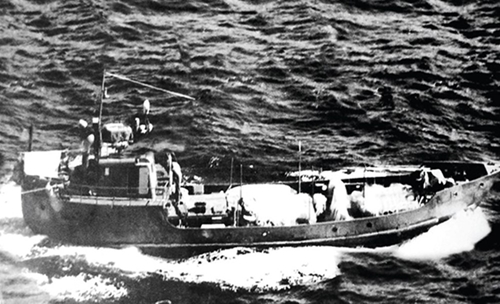Following the 1954 Geneva Accords, the U.S. imperialists violated its commitments, partitioning Vietnam and turning the South into a new-style colony and a military stronghold. In response, the Party Central Committee resolved that to protect revolutionary achievements and liberate the South, it was impossible to pin all hopes on a peaceful solution, but gearing up for a protracted and armed struggle was a must.
    |
 |
|
During the war against the U.S. imperialists, Vietnam’s “No Number” naval ships braved storms and enemy blockades to transport weapons and personnel from the North to the South, creating the legendary “Ho Chi Minh Trail at Sea.” |
In May 1959, under the Politburo's direction, the General Military Commission decided to establish a division studying the supply of military assistance for the South, creating a comprehensive support strategy to serve the cause of national liberation. On May 19, 1959, a special military task force, later known as Group 559, was set up to form a strategic supply route through Truong Son Mountain Range to deliver weapons and supplies to the Southern battlefields.
However, due to the complex terrain and intense enemy surveillance, overland transport faced severe challenges. Recognizing this, the Party Central Committee adopted a strategic decision to open a maritime supply route. The move reflected the Party's visionariness in organizing forces and maximizing topographical and geographical advantages to serve the resistance war.
After a period of research, experimentation, learning from experience, and thorough preparation in all aspects, on October 23, 1961, the General Command established Military Transport Unit 759 (now Naval Brigade 125), officially launching a strategic transportation route – Ho Chi Minh Trail at Sea.
The unit was tasked with purchasing vehicles, organizing the delivery of weapons to the Southern battlefields by sea, adapting vessels to operate under the enemy's blockade, and training transport forces to navigate complex situations at sea.
The establishment of Unit 759 marked a pivotal turning point, leading to the birth of Ho Chi Minh Trail at Sea — one of the most influential strategic supply routes during the resistance war against the U.S. imperialists. It was also a groundbreaking move, demonstrating Vietnam's initiative and creativity in military strategy.
Timely response to Southern battlefields' demand
The sea trail comprised five major routes, stretching nearly 12,000 nautical miles (over 22,200km) in total. It became a vital bridge linking the North and the Southern battlefronts, including the farthest and fiercest ones like the South, the South-Central region, and coastal zones of Military Region 5.
With its unique natural conditions, the sea transport route enabled the delivery of large quantities of weapons, ammunition, military supplies, and equipment to the Southern battlefields, providing crucial resources for decisive military campaigns. Notably, the maritime route ensured timely supply during the most intense phases of the war, when land transport faced severe challenges.
The maritime transport force grew from just 38 pioneers to a full brigade, evolving from primitive wooden boats to steel-hulled vessels capable of long-range operations. Cleverly, sailors used international shipping lanes and blended in with fishing fleets to evade detection.
Although the volume of goods transported by sea was smaller compared to the overland route, its contribution was critical. Ho Chi Minh Trail at Sea is widely regarded as a shining example of Vietnam’s military ingenuity, epoch-making revolutionary will and acts, and creative strategy that matched the resistance war's situation.
The trail is a powerful symbol of the indomitability, ingenuity, and unity of the Vietnamese people during their fight for national independence and reunification. The timeless lessons from this legendary route continue to inspire generations today, driving Vietnam forward on its path of growth and development.
On November 26, 2024, the Vietnamese Government officially recognized Ho Chi Minh Trail at Sea as a special national relic, honoring the sacrifices of those who contributed to the South liberation and national reunification and also enhancing patriotism among the entire people.
Source: VNA